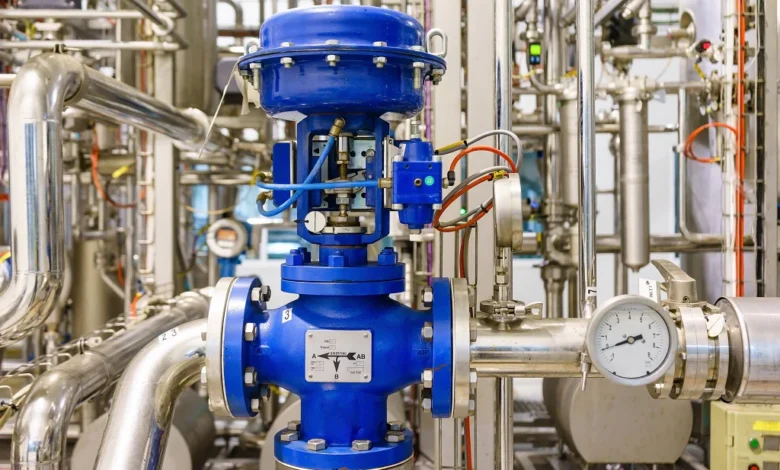Control Valves: The Essential Guide for Industry and Everyday Applications

Control valves might not be the first thing that comes to mind when considering how vital systems work in industries or even in some everyday applications. However, these small yet incredibly powerful devices play a critical role in regulating the flow, pressure, and temperature of fluids and gases, ensuring the safe and efficient operation of countless systems. From oil and gas pipelines to heating, ventilation, and air conditioning (HVAC) systems in buildings, control valves are crucial components that help maintain optimal working conditions.
In this article, we’ll dive into the world of control valves, exploring their purpose, types, design principles, applications, and much more. By the end, you’ll have a well-rounded understanding of how control valves work and why they are indispensable in various industries and systems.
What Are Control Valves?
At its core, a control valve is a mechanical device that regulates the flow of a fluid (which could be a liquid, gas, or steam) through a piping system. The purpose of this regulation is to maintain the desired pressure, flow rate, or temperature within the system. In a way, control valves function as the “gatekeepers” of a system, ensuring that fluid flows at the right pace and pressure to achieve safe and optimal operation.
Control valves operate by adjusting their internal openings, which are often referred to as orifices or seats. By increasing or decreasing the opening, control valves can restrict or allow more fluid through the system, depending on the desired conditions.
The Importance of Control Valves

Control valves are essential in maintaining the safety and efficiency of various industrial and commercial processes. By regulating flow, pressure, and temperature, these valves play a pivotal role in:
- Protecting equipment from damage due to excessive pressure or temperature
- Ensuring efficient energy use by reducing unnecessary flow rates
- Improving the quality of products in industries where precise temperature and flow control are necessary
- Enhancing safety by preventing dangerous overflows or pressure buildups
Components of a Control Valve
Control valves may vary in design, but they generally consist of a few main components. Here’s a breakdown of the essential parts:
- Valve Body: The main housing of the valve that contains all the internal parts. This body is typically made from durable materials like stainless steel or brass to withstand high-pressure environments.
- Actuator: The part that moves the valve stem to open, close, or partially restrict the flow of fluid. Actuators can be powered by electricity, air, or hydraulics, depending on the application.
- Valve Stem: A slender rod connecting the actuator to the valve disc or plug. Movement of the stem adjusts the position of the plug, thereby controlling fluid flow.
- Valve Plug or Disc: The component that sits against the valve seat to regulate the flow. The shape and size of the plug determine how much fluid can pass through the valve when it’s in different positions.
- Valve Seat: The internal surface where the plug or disc rests when the valve is closed, forming a seal to prevent fluid passage.
Each component works together to make control valves responsive and effective in managing fluid flow, pressure, and temperature.
Types of Control Valves
Control valves come in various types, each tailored to suit different needs and operating conditions. Below are some of the most common types and their unique characteristics.
1. Globe Valves
Globe valves are perhaps the most widely used control valves due to their excellent throttling capabilities. The body of a globe valve has an S-shaped design that allows fluid to flow smoothly around the internal plug. Globe valves offer precise flow control and are commonly used in high-pressure and high-temperature applications, such as steam systems.
2. Ball Valves
Ball valves use a spherical disc with a hole in the middle to control flow. When the hole aligns with the pipe, fluid can pass through; when the ball rotates, the passage closes. Known for their durability and ability to completely shut off flow, ball valves are frequently used in systems where quick on-off operation is essential.
3. Butterfly Valves
Butterfly valves consist of a circular disc attached to a rotating shaft. When the shaft is turned, the disc rotates to either allow or block fluid flow. Due to their lightweight and compact design, butterfly valves are ideal for large-volume flow systems, such as water distribution networks and HVAC systems.
4. Diaphragm Valves
In diaphragm valves, a flexible diaphragm moves up and down to control fluid flow. When the diaphragm presses against the valve seat, it restricts fluid movement. These valves are especially suitable for handling corrosive or viscous fluids, as the diaphragm provides a secure seal against leaks and contamination.
5. Needle Valves
Needle valves have a long, tapered stem with a narrow, pointed tip that sits tightly against the valve seat. This precise configuration allows fine adjustments of flow, making needle valves ideal for applications where accurate control is crucial, such as laboratory equipment or fuel metering systems.
6. Pinch Valves
Pinch valves use a flexible sleeve that can be pinched closed by an external mechanism to control fluid flow. They are typically used for handling slurries, powders, and granular materials, as the flexible sleeve provides a tight seal and prevents clogging.
Each valve type is designed to handle different fluids, pressures, and temperatures, making them versatile across various industrial settings.
How Control Valves Work
Control valves operate through a combination of automated signals and mechanical adjustments. Most modern control valves use actuators controlled by electronic signals from a central system. Here’s a step-by-step breakdown of the process:
- Signal Transmission: A central system, typically a programmable logic controller (PLC) or distributed control system (DCS), sends a signal to the actuator based on the current operating conditions. The signal indicates whether to increase, decrease, or maintain the fluid flow.
- Actuator Movement: The actuator receives the signal and moves the valve stem accordingly. This movement adjusts the valve plug or disc to either restrict or allow fluid flow through the valve body.
- Flow Regulation: As the valve plug moves, it changes the size of the internal opening, allowing more or less fluid to pass through. This adjustment regulates the flow rate, pressure, or temperature of the fluid in the system.
- Feedback Loop: In many systems, sensors monitor the actual conditions and provide feedback to the control system. If the conditions deviate from the set parameters, the system makes further adjustments to the valve position.
This process of signal transmission, adjustment, and feedback enables control valves to precisely manage fluid flow, creating a stable and efficient system.
Actuator Types and Their Roles in Control Valves
Actuators are critical for automated control valves as they provide the force needed to move the valve stem. Different actuators serve various purposes based on their power sources and characteristics:
- Pneumatic Actuators: These use compressed air to control valve movement. Pneumatic actuators are quick and reliable, making them popular in applications where fast response is essential. They are also safe in hazardous environments since they don’t require electricity.
- Electric Actuators: Electric actuators use motors to drive valve movement and are common in systems requiring precise control. Electric actuators are typically programmable, allowing for greater customization and control over valve operation.
- Hydraulic Actuators: These actuators use pressurized liquid (usually oil) to move the valve stem. Known for their strength, hydraulic actuators are ideal for large valves or applications with high fluid pressures.
Each actuator type offers unique advantages, and the choice often depends on factors like response speed, environmental safety, and system requirements.
Common Applications of Control Valves
Control valves are used in various industries, each application requiring specific control functions to ensure smooth and safe operations. Here’s a look at some common fields where control valves are essential.
1. Oil and Gas Industry
In oil and gas, control valves regulate pressure, flow, and temperature in extraction, transportation, and refining processes. These valves must withstand high pressures, harsh environments, and corrosive fluids. Control valves in this industry are vital for maintaining process efficiency and minimizing risks, particularly in high-stakes operations like offshore drilling and refining.
2. Water Treatment Plants
Water treatment facilities use control valves to manage water flow, pressure, and chemical dosing. Precision is essential to ensure treated water meets quality standards, and control valves play a pivotal role in regulating each stage of water purification.
3. HVAC Systems
Heating, ventilation, and air conditioning systems use control valves to regulate water and air flow. In an HVAC system, control valves maintain comfortable indoor temperatures by managing the flow of hot or cold water and air through the system, improving energy efficiency and ensuring consistent comfort.
4. Power Generation
In power plants, control valves manage the flow of steam and cooling water. These valves are crucial in maintaining the right pressure and temperature to generate electricity safely and efficiently. Control valves are also used in nuclear power plants, where precision is critical to avoid any system instability.
5. Pharmaceutical and Chemical Manufacturing
Precise control of fluid flow and pressure is essential in pharmaceutical and chemical manufacturing to ensure product quality. Control valves help maintain specific conditions for chemical reactions, mixing, and ingredient dosages, which are fundamental in producing consistent and safe products.
Control Valve Sizing and Selection
Choosing the right control valve is crucial for optimal system performance. Selecting the wrong size or type can lead to inefficiencies, increased wear and tear, and even system failures. Here are key considerations when selecting a control valve:
- Flow Capacity (Cv): This parameter represents the flow capacity of a valve and is essential for determining the right size. The Cv value indicates how much fluid can pass through the valve at a given pressure drop.
- Material Compatibility: Selecting a valve made from materials compatible with the fluid is vital, especially for corrosive or high-temperature substances.
- Pressure and Temperature Ratings: Control valves must be able to withstand the pressure and temperature ranges of the system without compromising safety or functionality.
- Valve Type and Characteristics: Consider the nature of the application, as each valve type has unique capabilities. For instance, globe valves are excellent for precise flow control, while ball valves are better for quick on-off functions.
Proper sizing and selection ensure that the valve operates efficiently, prolongs its lifespan, and minimizes the risk of leaks or system disruptions.
Control Valve Maintenance and Troubleshooting
Regular maintenance is essential to keep control valves in good working order. Over time, wear and tear can lead to problems such as leaks, corrosion, or even mechanical failures. Here are some maintenance tips:
- Routine Inspection: Regularly inspect control valves for signs of wear, corrosion, or leaks. Early detection helps prevent more severe problems.
- Lubrication: Keep moving parts well-lubricated to reduce friction and wear. This is particularly important for valves with frequent actuation.
- Seal Replacement: Worn seals can lead to leaks. Replacing seals periodically ensures a tight closure and prevents fluid loss.
- Cleaning: If the valve is handling materials that may clog or deposit, clean it periodically to maintain proper flow.
If a control valve malfunctions, consider troubleshooting steps such as checking for signal issues, inspecting the actuator, and verifying if the valve seat and plug are correctly aligned.
Innovations in Control Valve Technology
As technology advances, so do control valves. Today, smart valves equipped with sensors and diagnostic capabilities are becoming common. These smart valves can monitor and report on their condition, predict maintenance needs, and adjust to optimize performance based on real-time data. Innovations like these improve system efficiency, reduce downtime, and allow industries to maintain precise control with less manual intervention.
Conclusion
Control valves might seem like small components, but their role in regulating the safe and efficient flow of fluids is nothing short of essential. From the oil and gas industry to HVAC systems in everyday buildings, control valves are indispensable for maintaining stable operations. With various types and components designed to suit different applications, control valves are versatile tools in modern engineering. Whether it’s through precise flow adjustments or automated control in smart systems, control valves are the unsung heroes of industrial and commercial systems, ensuring that everything runs smoothly, safely, and efficiently.



